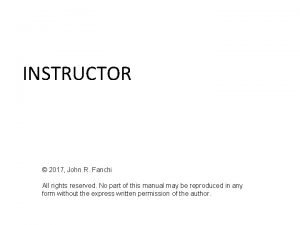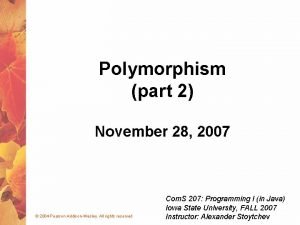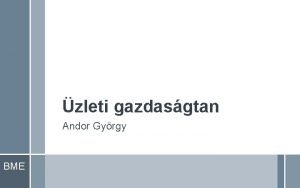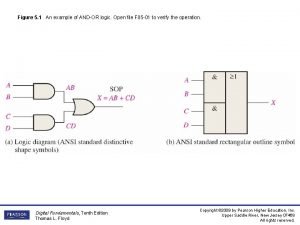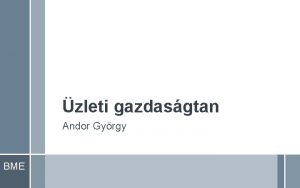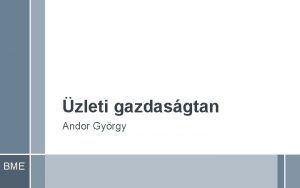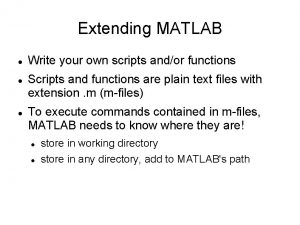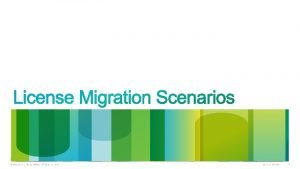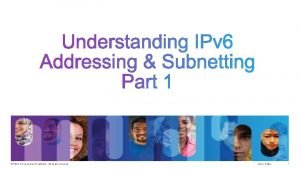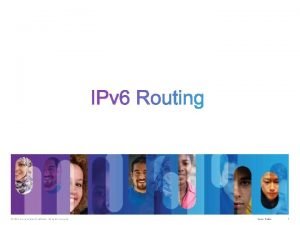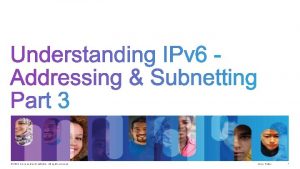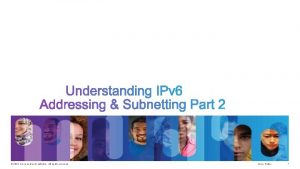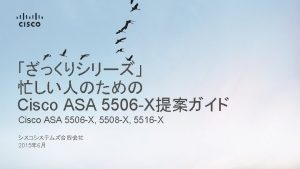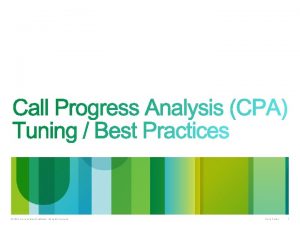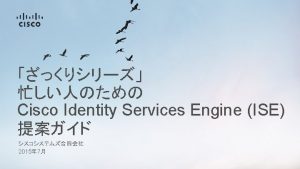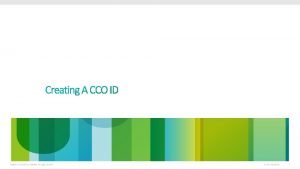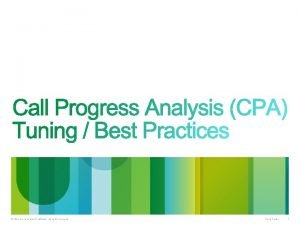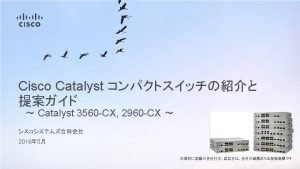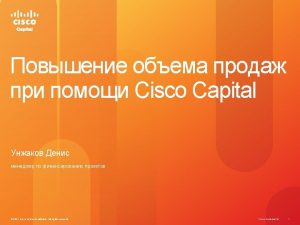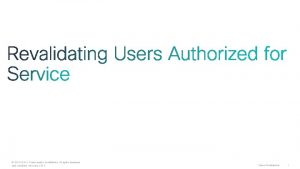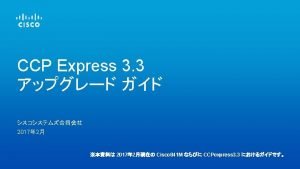2013 Cisco andor its affiliates All rights reserved














































- Slides: 46

© 2013 Cisco and/or its affiliates. All rights reserved. Cisco Public 1

• Introduction to ICMPv 6 • Echo Request and Echo Reply • Neighbor Discovery • Neighbor Cache Cisco Networking Academy, US/Canada © 2013 Cisco Systems, Inc. All rights reserved. Cisco confidential. 2

© 2013 Cisco and/or its affiliates. All rights reserved. Cisco Public 3

• Similar to ICMP for IPv 4 • More robust • New features • Improving upon similar functionality • Both ICMP and ICMPv 6 use types and codes • Two types of ICMPv 6 messages • Error messages • Informational messages Cisco Networking Academy, US/Canada © 2013 Cisco Systems, Inc. All rights reserved. Cisco confidential. 4

• IPv 6 routing is off by default in Cisco IOS • R 1(config)# ipv 6 unicast-routing • Global configuration mode to enable IPv 6 Routing Cisco Networking Academy, US/Canada © 2013 Cisco Systems, Inc. All rights reserved. Cisco confidential. 5

ICMPv 6 Next Header Value: 58 decimal or 3 A hexadecimal Next Header 58 ICMPv 6 Message Body ICMPv 6 Header IPv 6 Data ICMPv 6 General Message Format 8 Type 16 Code 24 32 Checksum Message Body Cisco Networking Academy, US/Canada © 2013 Cisco Systems, Inc. All rights reserved. Cisco confidential. 6

Type = 0 to 127 (8 bit field with first bit off 0 xxxxxxx) Cisco Networking Academy, US/Canada © 2013 Cisco Systems, Inc. All rights reserved. Cisco confidential. 7

Type = 128 – 255 (8 bit field with first bit on 1 xxxxxxx) Cisco Networking Academy, US/Canada © 2013 Cisco Systems, Inc. All rights reserved. Cisco confidential. 8

© 2013 Cisco and/or its affiliates. All rights reserved. Cisco Public 9

Echo Reply: Type = 128 Echo Request: Type = 129 8 Type = 128 or 129 16 Code = 0 24 32 Checksum Identifier Sequence Number Data • Like IPv 4, ICMPv 6 Echo Request and Echo Reply are two ICMP messages used by ping Cisco Networking Academy, US/Canada © 2013 Cisco Systems, Inc. All rights reserved. Cisco confidential. 10

R 1 Fa 0/0 2001: DB 8: AAAA: 1: : 1 FE 80: : 1/64 Ping PC 1 PC 2 2001: DB 8: AAAA: 1: : 100 FE 80: : 50 A 5: 8 A 35: A 5 bb: 66 E 1 Cisco Networking Academy, US/Canada © 2013 Cisco Systems, Inc. All rights reserved. Cisco confidential. 11

PC 1> ping 2001: db 8: aaaa: 1: : 1 Pinging 2001: db 8: aaaa: 1: : 1 from 2001: db 8: aaaa: 1: : 100 with 32 bytes of data: Reply from 2001: db 8: aaaa: 1: : 1: time=1 ms Ping statistics for 2001: db 8: aaaa: 1: Packets: Sent = 4, Received = 4, Lost = 0 (0% loss), Approximate round trip times in milli-seconds: Minimum = 1 ms, Maximum = 1 ms, Average = 1 ms Cisco Networking Academy, US/Canada © 2013 Cisco Systems, Inc. All rights reserved. Cisco confidential. 12

Internet Protocol Version 6 0110. . = Version: 6. . 0000. . . . . = Traffic class: 0 x 0000. . . 0000 0000 = Flowlabel: 0 x 0000 Payload length: 40 Next header: ICMPv 6 (0 x 3 a) Hop limit: 128 Source: 2001: db 8: aaaa: 1: : 100 Destination: 2001: db 8: aaaa: 1: : 1 Internet Control Message Protocol v 6 Type: 128 (Echo (ping) request) Code: 0 (Should always be zero) Checksum: 0 x 8 f 38 [correct] ID: 0 x 0001 Sequence: 0 Data (32 bytes) Cisco Networking Academy, US/Canada © 2013 Cisco Systems, Inc. All rights reserved. Cisco confidential. 13

Internet Protocol Version 6 0110. . = Version: 6. . 0000. . . . . = Traffic class: 0 x 0000. . . 0000 0000 = Flowlabel: 0 x 0000 Payload length: 40 Next header: ICMPv 6 (0 x 3 a) Hop limit: 64 Source: 2001: db 8: aaaa: 1: : 1 Destination: 2001: db 8: aaaa: 1: : 100 Internet Control Message Protocol v 6 Type: 129 (Echo (ping) reply) Code: 0 (Should always be zero) Checksum: 0 x 8 e 38 [correct] ID: 0 x 0001 Sequence: 0 Data (32 bytes) Cisco Networking Academy, US/Canada © 2013 Cisco Systems, Inc. All rights reserved. Cisco confidential. 14

R 1# ping fe 80: : 50 a 5: 8 a 35: a 5 bb: 66 e 1 Output Interface: fastethernet 0/0 % Invalid interface. Use full interface name without spaces (e. g. Serial 0/1) R 1# ping fe 80: : 50 a 5: 8 a 35: a 5 bb: 66 e 1 Output Interface: fastethernet 0/0 Type escape sequence to abort. Sending 5, 100 -byte ICMP Echos to FE 80: : 50 A 5: 8 A 35: A 5 BB: 66 E 1, timeout is 2 seconds: !!!!! Success rate is 100 percent (5/5), round-trip min/avg/max = 1/2/4 ms Cisco Networking Academy, US/Canada © 2013 Cisco Systems, Inc. All rights reserved. Cisco confidential. 15

Internet Protocol Version 6 0110. . = Version: 6. . 0000. . . . . = Traffic class: 0 x 0000. . . 0000 0000 = Flowlabel: 0 x 0000 Payload length: 60 Next header: ICMPv 6 (0 x 3 a) Hop limit: 64 Source: fe 80: : 1 Destination: fe 80: : 50 a 5: 8 a 35: a 5 bb: 66 e 1 Internet Control Message Protocol v 6 Type: 128 (Echo (ping) request) Code: 0 (Should always be zero) Checksum: 0 x 0444 [correct] ID: 0 x 0 a 24 Sequence: 0 Data (52 bytes) Cisco Networking Academy, US/Canada © 2013 Cisco Systems, Inc. All rights reserved. Cisco confidential. 16

Internet Protocol Version 6 0110. . = Version: 6. . 0000. . . . . = Traffic class: 0 x 0000. . . 0000 0000 = Flowlabel: 0 x 0000 Payload length: 60 Next header: ICMPv 6 (0 x 3 a) Hop limit: 64 Source: fe 80: : 50 a 5: 8 a 35: a 5 bb: 66 e 1 Destination: fe 80: : 1 Internet Control Message Protocol v 6 Type: 129 (Echo (ping) reply) Code: 0 (Should always be zero) Checksum: 0 x 0344 [correct] ID: 0 x 0 a 24 Sequence: 0 Data (52 bytes) Cisco Networking Academy, US/Canada © 2013 Cisco Systems, Inc. All rights reserved. Cisco confidential. 17

© 2013 Cisco and/or its affiliates. All rights reserved. Cisco Public 18

• Neighbors with IPv 6 • Routers • Hosts • So Neighbor Discovery means host to host communication or router to host communication, a router can also be a host • IPv 6 designers wanted IPv 6 to be plug and play at the user’s end • Processes are called Neighbor Discovery Processes and are implemented using ICMPv 6 messages Cisco Networking Academy, US/Canada © 2013 Cisco Systems, Inc. All rights reserved. Cisco confidential. 19

• Router Solicitation – Type 133 • Router Advertisement – Type 134 • Neighbor Solicitation – Type 135 • Neighbor Advertisement – Type 136 • Redirect Message – Type 137 Cisco Networking Academy, US/Canada © 2013 Cisco Systems, Inc. All rights reserved. Cisco confidential. 20

• Communication between a host and router • Router Solicitation • Sent by host (remember a router can be a host) • When host needs addressing and other configuration information important as part of SLAAC • Router Advertisement • Sent periodically (every 200 seconds on Cisco IOS) • Sent in response to Router Solicitation • Provides addressing and other configuration information important as part of SLAAC Cisco Networking Academy, US/Canada © 2013 Cisco Systems, Inc. All rights reserved. Cisco confidential. 21

• Used by a device to: • Request Layer 2 address information from another device on the same network • Provide this information to the requesting device • Part of three important processes: • Address Resolution • Duplicate Address Detection (DAD) • Neighbor Unreachability Detection (NUD) Cisco Networking Academy, US/Canada © 2013 Cisco Systems, Inc. All rights reserved. Cisco confidential. 22

Terms • ND or NDP – Neighbor Discovery Protocol • SLAAC – Stateless Address Autoconfiguration • DAD – Duplicate Address Detection Addresses • FF 02: : 1 All-nodes multicast • FF 02: : 2 All-routers multicast - Memory hint: routers are more important so thus the higher number Cisco Networking Academy, US/Canada © 2013 Cisco Systems, Inc. All rights reserved. Cisco confidential. 23

• IPv 6 routing is off by default in Cisco IOS • R 1(config)# ipv 6 unicast-routing • Global configuration mode to enable IPv 6 Routing Cisco Networking Academy, US/Canada © 2013 Cisco Systems, Inc. All rights reserved. Cisco confidential. 24

Stateless Address Auto Configuration can be explained using Neighbor Discovery Messages Prerequisites: 1. The host (PC 1) boots up 2. IPv 6 Configuration set to Auto Config 3. The host calculates the interface part of IPv 6 address using modified EUI-64 (depending on the operating system) 4. PC 1 then adds the link-local prefix FE 80 to the interface address to get a link-local IPv 6 address Cisco Networking Academy, US/Canada © 2013 Cisco Systems, Inc. All rights reserved. Cisco confidential. 25

R 1 PC 1 Cisco Networking Academy, US/Canada © 2013 Cisco Systems, Inc. All rights reserved. Cisco confidential. 26

1. Duplicate Address Detection (DAD) of Link-Local IPv 6 Address 2. Router Solicitation 3. Router Advertisement 4. Duplicate Address Detection of Global Unicast IPv 6 Address Cisco Networking Academy, US/Canada © 2013 Cisco Systems, Inc. All rights reserved. Cisco confidential. 27

PC 1 must verify that the link-local address is unique The Duplicate Address Detection(DAD) Neighbor Discovery Process is implemented The following ICMPv 6 Messages are used: 1) Neighbor Solicitation 2) Neighbor Advertisement Copy Cat Cisco Networking Academy, US/Canada © 2013 Cisco Systems, Inc. All rights reserved. Cisco confidential. 28

• Link-local address is in a tentative state until DAD is complete • Source address will be : : (unspecified ) • Destination address will be solicited-node multicast address of PC 1 • • • FF 02: : 1: FF 90: 41 B 0 Target address field is the link-local address FE 80: : 202: 4 AFF: FE 90: 41 B 0 PC 1 sets a timer If no Neighbor Advertisement message is received then it transitions the address from tentative to assigned PC 1 then sends a Neighbor Advertisement message indicating that its using the link-local address FE 80: : 202: 4 AFF: FE 90: 41 B 0 to other nodes in the link If a device has the same link-local it responds with a Neighbor Advertisement Address is then suspended on PC 1 Cisco Networking Academy, US/Canada © 2013 Cisco Systems, Inc. All rights reserved. Cisco confidential. 29

PC 1 sends Neighbor Solicitation to R 1 Cisco Networking Academy, US/Canada © 2013 Cisco Systems, Inc. All rights reserved. Cisco confidential. 30

Last step in DAD Process R 1 sends Neighbor Advertisement to PC 1 Link-local Cisco Networking Academy, US/Canada © 2013 Cisco Systems, Inc. All rights reserved. Cisco confidential. All-nodes Multicast 31

• PC 1 now needs a global unicast IPv 6 address to communicate outside of the link (network) • PC 1 needs to find a router on its link • PC 1 has to perform the Router Discovery Process • PC 1 sends a Router Solicitation Message • Source address will be link-local address of PC 1 FE 80: : 202: 4 AFF: FE 90: 41 B 0 • Destination address will be FF 02: : 2 (All-routers multicast) Cisco Networking Academy, US/Canada © 2013 Cisco Systems, Inc. All rights reserved. Cisco confidential. 32

PC 1 sends Router Solicitation to R 1 Cisco Networking Academy, US/Canada © 2013 Cisco Systems, Inc. All rights reserved. Cisco confidential. 33

• R 1 sends Router Advertisement if ipv 6 unicast-routing is enabled on the router • Source address is link-local address of the R 1’s inferface FE 80: : 1 • Destination Address is FF 02: : 1 (All Nodes Multicast) • R 1 sends the following information to PC 1 1) Global Prefix and Prefix Length 2) Layer 2 Address of the interface sending Router Advertisement 3) Link MTU 4) Timers to check reachability 5) M and O flags Cisco Networking Academy, US/Canada © 2013 Cisco Systems, Inc. All rights reserved. Cisco confidential. 34

R 1 sends Router Advertisement to PC 1 Cisco Networking Academy, US/Canada © 2013 Cisco Systems, Inc. All rights reserved. Cisco confidential. 35

Cisco Networking Academy, US/Canada © 2013 Cisco Systems, Inc. All rights reserved. Cisco confidential. 36

Cisco Networking Academy, US/Canada © 2013 Cisco Systems, Inc. All rights reserved. Cisco confidential. 37

• PC 1 has to check whether the global unicast is unique • Perfoms Duplicate Address Detection • Sends a Neighbor Solicitation message with global IPv 6 unicast address as the Target Address • Once process ends and address is confirmed unique PC 1 sends a Neighbor Advertisement message to announce its global unicast IPv 6 address Cisco Networking Academy, US/Canada © 2013 Cisco Systems, Inc. All rights reserved. Cisco confidential. 38

Cisco Networking Academy, US/Canada © 2013 Cisco Systems, Inc. All rights reserved. Cisco confidential. 39

Cisco Networking Academy, US/Canada © 2013 Cisco Systems, Inc. All rights reserved. Cisco confidential. 40

Cisco Networking Academy, US/Canada © 2013 Cisco Systems, Inc. All rights reserved. Cisco confidential. 41

© 2013 Cisco and/or its affiliates. All rights reserved. Cisco Public 42

Neighbor Cache IPv 6 Address MAC Address 2001: DB 8: ACAD: 1: : 10 0021. 9 bd 9. c 644 PC 1 IPv 6 - 2001: DB 8: ACAD: 1: : 10 MAC - 0021. 9 bd 9. c 644 • Neighbor Cache – Maps IPv 6 addresses with Ethernet MAC addresses • Similar to ARP Cache for IPv 4 • 5 States (2 noticeable and 3 transitory): • Reachable: Packets have recently been received providing confirmation • • that this device is reachable. Stale: A certain time period has elapsed since a packet has been received from this address. Transitory States: INCOMPLETE, DELAY, PROBE Cisco Networking Academy, US/Canada © 2013 Cisco Systems, Inc. All rights reserved. Cisco confidential. 43

R 1# show ipv 6 neighbors IPv 6 Address FE 80: : 50 A 5: 8 A 35: A 5 BB: 66 E 1 2001: db 8: aaaa: 1: : 100 Age Link-layer Addr State Interface 16 0021. 9 bd 9. c 644 STALE Fa 0/0 R 1# ping 2001: db 8: aaaa: 1: : 100 Type escape sequence to abort. Sending 5, 100 -byte ICMP Echos to 2001: DB 8: AAAA: 1: : 100, timeout is 2 seconds: !!!!! Success rate is 100 percent (5/5), round-trip min/avg/max = 1/1/1 ms R 1# show ipv 6 neighbors IPv 6 Address FE 80: : 50 A 5: 8 A 35: A 5 BB: 66 E 1 2001: DB 8: AAAA: 1: : 100 Cisco Networking Academy, US/Canada Age Link-layer Addr State Interface 16 0021. 9 bd 9. c 644 STALE Fa 0/0 0 0021. 9 bd 9. c 644 REACH Fa 0/0 © 2013 Cisco Systems, Inc. All rights reserved. Cisco confidential. 44

© 2013 Cisco and/or its affiliates. All rights reserved. Cisco Public 45

Thank you.
 Usa hockey affiliates
Usa hockey affiliates All rights reserved example
All rights reserved example Copyright 2015 all rights reserved
Copyright 2015 all rights reserved All rights reserved sentence
All rights reserved sentence Freesound content licence
Freesound content licence Confidential all rights reserved
Confidential all rights reserved Sentinel-controlled repetition
Sentinel-controlled repetition Copyright © 2015 all rights reserved
Copyright © 2015 all rights reserved 2012 pearson education inc
2012 pearson education inc Microsoft corporation. all rights reserved.
Microsoft corporation. all rights reserved. Microsoft corporation. all rights reserved
Microsoft corporation. all rights reserved Microsoft corporation. all rights reserved
Microsoft corporation. all rights reserved Pearson education inc. all rights reserved
Pearson education inc. all rights reserved Dell all rights reserved copyright 2009
Dell all rights reserved copyright 2009 Warning all rights reserved
Warning all rights reserved C all rights reserved
C all rights reserved All rights reserved formula
All rights reserved formula Warning all rights reserved
Warning all rights reserved Confidential all rights reserved
Confidential all rights reserved Microsoft corporation. all rights reserved
Microsoft corporation. all rights reserved 2010 pearson education inc
2010 pearson education inc Copyright © 2018 all rights reserved
Copyright © 2018 all rights reserved 2017 all rights reserved
2017 all rights reserved Pearson education inc all rights reserved
Pearson education inc all rights reserved 2010 pearson education inc
2010 pearson education inc Confidential all rights reserved
Confidential all rights reserved Confidential all rights reserved
Confidential all rights reserved R rights reserved
R rights reserved Rights reserved
Rights reserved Andor györgy
Andor györgy How are the inner planets alike
How are the inner planets alike Andor logic
Andor logic Andor györgy üzleti gazdaságtan
Andor györgy üzleti gazdaságtan Andor basic
Andor basic Andor györgy üzleti gazdaságtan
Andor györgy üzleti gazdaságtan Andor györgy üzleti gazdaságtan
Andor györgy üzleti gazdaságtan Whatever text
Whatever text Python andor
Python andor Andor matlab
Andor matlab Positive vs negative rights
Positive vs negative rights Riparian vs littoral
Riparian vs littoral Conclusion of rights
Conclusion of rights Legal rights vs moral rights
Legal rights vs moral rights Positive vs negative rights
Positive vs negative rights Negative rights vs positive rights
Negative rights vs positive rights Positive rights vs negative rights
Positive rights vs negative rights Negative right
Negative right



























